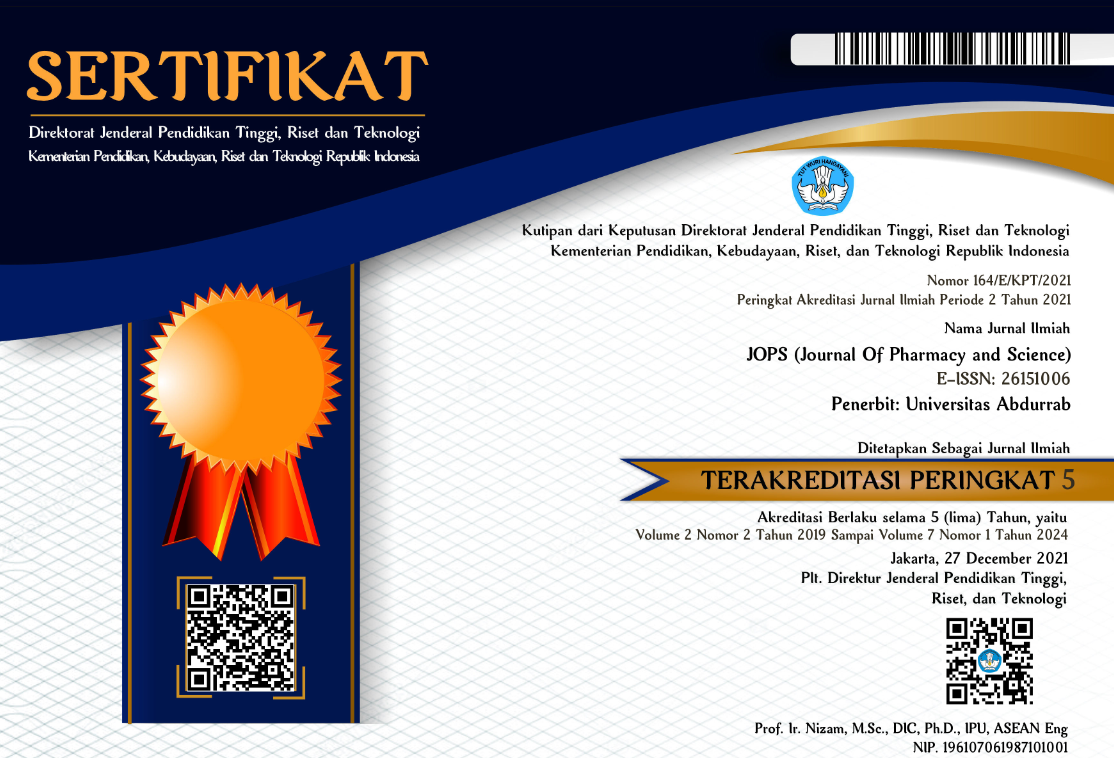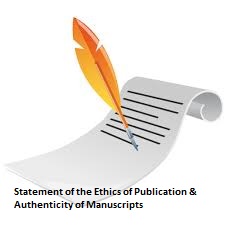Chemical profiling of African leaves (Vernonia amygdalina Delile) and Kenikir leaves (Cosmos caudatus Kunth) extracts using Thin Layer Chromatography (TLC)
Abstract
African leaves (Vernonia amygdalina Delile) and kenikir leaves (Cosmos caudatus Kunth) are plants that belong to the asteraceae family. Members of asteraceae have been used in food and medicine for centuries. This study aims to determine the secondary metabolite compounds contained in African leaves extracts and kenikir leaves through phytochemical screening using Thin-layer chromatography (TLC) method detected using UV 254nm and UV 366 nm light, as well as spot revealers that match the chemical group. The results of phytochemical screening using KLT show that African leaves contain flavonoids, terpenoids. And kenikir leaf extract is positive for steroids and flavonoids, one of them which is isocuesitrin.
References
Arsul, M. I., Tahar, N., & Rauf, A. (2022). Analisis Kualitatif dan Kuantitatif Antioksidan Parang Romang: Qualitative and Quantitative Antioxidant Analysis of Parang Romang. Jurnal Sains dan Kesehatan, 4(4), 379-385.
Auner, B. G., Wirth, M., & Valenta, C, 2005, Antioxidative activity and cytotoxicity of four different flavonoids for dermal applications. Journal of drug delivery science and technology, 15(3), 227-232.
Bestari, R, 2021, Senyawa fitokimia dan aktivitas farmakologis daun afrika (vernonia amygdalina del.) Sebagai kandidat obat herbal. Jurnal Kedokteran STM (Sains dan Teknologi Medik), 4(1), 63-74.
Bunawan, H., Baharum, S.N., Bunawan, S.N., Amin, N.M. and Noor, N.M., 2014, Cosmos caudatus Kunth: A traditional medicinal herb. Global Journal of Pharmacology, 8(3), pp.420-426.
Cheng, S. H., Ismail, A., Anthony, J., Ng, O. C., Hamid, A. A., & Barakatun-Nisak, M. Y, 2015, Eight weeks of Cosmos caudatus (ulam raja) supplementation improves glycemic status in patients with type 2 diabetes: a randomized controlled trial. Evidence-Based Complementary and Alternative Medicine, 2015.
Danladi, S. Alkassim, H. M., Idris, A. M., dan Idris I. U, 2018, “Vernonia amygdalina Del: A Mini Review’, Research Journal of Pharmacy and Technology, 11(9), pp. 4187–4190.
Duke, S. O., Blair, A. C., Dayan, F. E., Johnson, R. D., Meepagala, K. M., Cook, D., & Bajsa, J, 2009, Is (−)-catechin a novel weapon of spotted knapweed (Centaurea stoebe)?. Journal of chemical ecology, 35, 141-153.
Gandjar, I. G., & Rohman, A, 2007, Kimia farmasi analisis. Yogyakarta: Pustaka Pelajar, 224, 228.
Ikalinus, R., Widyastuti, S. K., & Setiasih, N. L. E. (2015). Skrining fitokimia ekstrak etanol kulit batang kelor (Moringa oleifera). Indonesia Medicus Veterinus, 4(1), 71-79.
Kemenkes, R. I, 2017,. Farmakope Herbal Indonesia Edisi II. Jakarta: Kementrian Kesehatan RI.
Moshawih, S., Cheema, M. S., Ahmad, Z., Zakaria, Z. A., & Hakim, M. N, 2017, A comprehensive review on Cosmos caudatus (Ulam raja): pharmacology, ethnopharmacology, and phytochemistry. International Research Journal of Education and Sciences, 1(1), 14-31.
Mustafa, R. A., Hamid, A. A., Mohamed, S., & Bakar, F. A, 2010, Total phenolic compounds, flavonoids, and radical scavenging activity of 21 selected tropical plants. Journal of food science, 75(1), C28-C35.
Nikolić, M., & Stevović, S. ,2015, Family Asteraceae as a sustainable planning tool in phytoremediation and its relevance in urban areas. Urban Forestry & Urban Greening, 14(4), 782-789.
Revianto, R., Rahayu, A., & Mulyaningsih, Y, 2017, Pertumbuhan Dan Produksi Tanaman Kenikir (Cosmos caudatus Kunth.) pada Berbagai Tingkat Naungan. Jurnal Agronida, 3(2).
Shui, G., Leong, L. P., & Wong, S. P, 2005, Rapid screening and characterisation of antioxidants of Cosmos caudatus using liquid chromatography coupled with mass spectrometry. Journal of Chromatography B, 827(1), 127-138.
Tandi, J., Claresta, J. A., Ayu, G., & Irwan, I. ,2018, Effect of ethanol extract of kenikir (Cosmos caudatus Kunth.) leaves in blood glucose, cholesterol and histopathology pancreas of male white rats (Rattus norvegicus). Indonesian Journal of Pharmaceutical Science and Technology, 1(1), 70-78.
Wijono, S. H, 2003, Isolasi dan identifikasi flavonoid pada daun katu (Sauropus androgynus (L.) Merr). Makara Journal of Science, 7(2), 2.
Yeap, S. K., Ho, W. Y., Beh, B. K., Liang, W. S., Ky, H., Yousr, A. H. N., & Alitheen, N. B, 2010, Vernonia amygdalina, an ethnoveterinary and ethnomedical used green vegetable with multiple bioactivities. Journal of medicinal plants research, 4(25), 2787-2812.
Yusoff, N. A. H., Sanuan, F. M., & Rukayadi, Y, 2015, Cosmos caudatus Kunth. extract reduced number of microflora in oyster mushroom (Pleurotus ostreatus). International Food Research Journal, 22(5).
Copyright (c) 2023 JOPS (Journal Of Pharmacy and Science)

This work is licensed under a Creative Commons Attribution-NonCommercial-ShareAlike 4.0 International License.
1. Copyright of all journal manuscripts is held by the JOPS (Journal Of Pharmacy and Science)
2. Formal legal provisions to access digital articles of electronic journal are subject to the provision of the Creative Commons Attribution-ShareAlike license (CC BY-NC-SA), which means that JOPS (Journal Of Pharmacy and Science) is rightful to keep, transfer media/format, manage in the form of databases, maintain, and publish articles.
3. Published manuscripts both printed and electronic are open access for educational, research, and library purposes. Additiponally, the editorial board is not responsible for any violations of copyright law.
licensed under a Creative Commons Attribution-ShareAlike 4.0 International License.
 PDF (Bahasa Indonesia)
PDF (Bahasa Indonesia)
 Abstract views: 112
Abstract views: 112
 downloads: 105
downloads: 105

 :
:
1.png)








